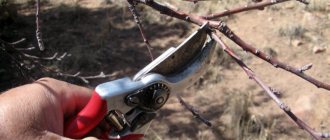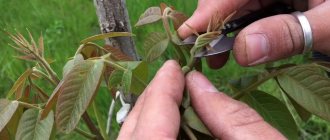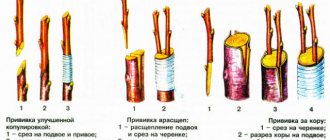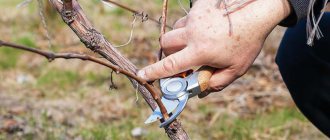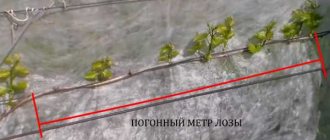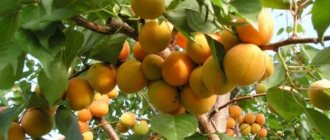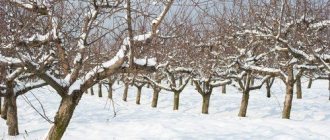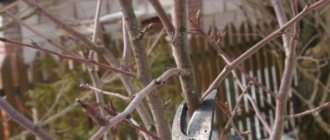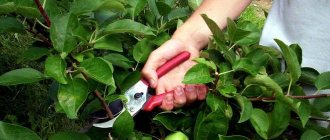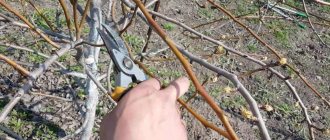In the southern regions of Russia, peach is one of the most popular fruit trees. Due to the presence in its culture of varieties with different ripening periods, this juicy and incomparable fruit can be eaten from the end of June to the end of September, if you grow several trees on your plot, taking into account its early, middle and late varieties. Experienced gardeners do this when they deliberately take this factor into account when planting a peach.
Despite the seeming pickiness of the peach tree, with the simplest agricultural practices you can achieve a successful and high-quality harvest. One of the most significant methods for increasing the yield of its juicy fruits should be recognized as timely and correct pruning of this fruit tree. Even if you make some mistakes in the first steps of caring for it, you will not be left completely without a harvest.
In my personal gardening practice, I give preference to the peach, because it almost never has lean years. It suffers little from pests and is easy to prune even for novice amateurs. In addition, if you systematically monitor the crown of the tree and do not let it rise too high, then it is not difficult to collect its fruits.
Again, even with scanty summer rainfall, it needs little watering. The most important thing is to prevent the peach from suffering from fungal and viral diseases and the invasion of various types of aphids. It is believed that spraying Bordeaux mixture or, even more simply, Horus on pink buds and after flowering provides reliable protection throughout the peach growing season.
Do I need to trim a peach?
Peach trees should be pruned regularly - in spring, summer and autumn. This allows you to keep the tree healthy and attractive, making it easier to care for and harvest. A trimmed peach suffers less and produces more fruit. Main goals of haircut:
- Sanitary – removal of all weakened, broken, frost-damaged or disease-damaged branches. Thanks to this, only healthy parts of the crop will receive nutrients and water, which contributes to its development and maintenance of productivity.
- Rejuvenating - removing or shortening old branches to stimulate the growth of new shoots. Peach is characterized by increased metabolism - the tree spends a lot of energy providing nutrients to all branches. Therefore, you need to leave only those that bear fruit, as well as young shoots.
- Formative – to create a comfortable crown. If you do not prune, the peach will quickly thicken. This makes it difficult to care for and harvest. A dense crown is more difficult to rain, treat with pest control medications, and also remove fruits.
Pruning by year
It is necessary to know how to shape a peach immediately after planting it. Seedlings are pinched to a height of about 60 cm to give the crown a bowl shape. This is done before he reaches two years of age. The first main branches are cut to a height of up to 40 cm from ground level. For each of them, the upper bud should be on the outside.
Why do the ovaries of an apple tree fall off - what to do
Pruning a mature tree can be of different types. Depending on the purpose, it can be:
- Sanitary, with the removal of all damaged areas.
- Normalizing. This scheme is the most difficult for beginners. Necessary for the formation of new shoots.
- Formative. Leveling the tree crown and removing too large branches.
Important! When forming the crown, you need to pay attention to ensure that there are no long branches that stand out relative to the “bowl”.
When to trim a peach
The time for peach pruning is selected in accordance with the goal, as well as the characteristics of the plant itself. Most gardeners and agronomists agree that it is better to plan the main cutting for spring. At this time, sanitary and formative pruning is done. In summer, it is enough to adjust the crown in the desired direction, thin it out and remove all branches affected by diseases.
The main dates for peach pruning:
- Spring - at the moment of swelling of the buds, but before they open (the “pink bud” stage). This is an important difference from other garden trees and plants (they are recommended to be pruned earlier). According to other sources, peach pruning is carried out even during flowering.
- Summer - from mid-June to the second ten days of July, i.e. during the formation of fruits.
The main stage of peach pruning is planned for the end of March - beginning of April. Important!
When planning a haircut, it is necessary to take into account the climatic characteristics of the region. Spring pruning in the south is carried out at the end of March, and in the middle zone - in the second half of April. The timing of the summer procedure is approximately the same in all regions.
Is it possible to prune a peach in August?
Proper peach pruning involves removing all old branches that do not bear fruit or produce too little fruit. They receive a lot of nutrients that could be used to form healthy shoots. Therefore, after harvesting (in the second half of August), such branches are cut off completely.
Goals
Peach is a whimsical tree that requires careful and constant care, an obligatory part of which is the formation and pruning of the crown. Correct and timely haircut ensures:
- crown formation: controlling the height of the tree, giving a decorative silhouette, improving access to sunlight and optimal ventilation inside;
- timely and regular fruiting;
- increasing productivity;
- improving the quality of fruits (so that they are large and have excellent taste characteristics);
- increasing the period of fruiting;
- life extension;
- prevention and treatment of diseases;
- rejuvenation;
- stimulation of growth;
- strengthening the immune system;
- full preparation for winter, increasing resistance to low temperatures.
The peculiarity is that the winter hardiness of the peach tree depends on the shape of the crown:
- “spindlebush” (spindle, pyramid, column) winters well in the south (Cherkessk, Makhachkala);
- “bowl” - for the Krasnodar Territory, Rostov-on-Don;
- bush - for central Russia;
- stlanets - for more severe climatic conditions.
The second feature is the “gluttony” of the tree. The process of drawing nutrients from the roots occurs several times faster than in all other plants. Moreover, it uses them to develop branches. Therefore, in spring and summer a huge number of extra buds and shoots are formed. Because of them, the ovaries of future fruits lack nutrition. If you do not prune, only the periphery of the crown will bear fruit. The peaches will be small and tasteless. And the tree itself quickly ages and dies.
Features of pruning peach trees in spring and summer
Spring is the most important stage of tree trimming. At this time, sanitary and formative pruning is planned. For sanitary purposes, branches are removed:
- broken (to a healthy place);
- sick;
- crooked and rubbing against neighbors;
- growing inside the crown, excessively thickening it;
- located at an acute angle relative to the trunk (less than 40 degrees)
- formed at an obtuse angle (although they can be left).
To properly prune peaches, you need to take a closer look at its shoots. If two young branches (one or two year old) grow side by side, they will compete and interfere with each other. Therefore, the lower shoot is radically shortened, leaving 3 buds, and the top of the second shoot is pinched, leaving up to 10 buds. According to this scheme, you need to prune the entire peach tree in the spring.
Another task of spring pruning is the formation of the tree. The procedure is especially important for young peach seedlings. They work on the crown during the first 4–5 years of life, after which it is maintained in the given contours. You definitely need to choose a design - in the form of a bush or a bowl.
In summer, peach pruning is carried out during the formation of fruits, as well as after harvesting. At the first stage you need:
- Remove all weak and dried branches. At the same time, several non-fruiting shoots with abundant foliage should be left - they participate in photosynthesis and feed the tree well.
- Completely remove all branches that grow deep into the crown. You can leave a few shoots if they do not interfere with harvesting.
- Slightly shorten fruiting branches on which too many ovaries have formed. Otherwise, they may break under the weight of ripening peaches.
At the second stage, all non-fruit-bearing branches (if any remain), as well as drying and disease-affected shoots, are pruned.
In spring, sanitary and formative pruning is carried out.
Optimal timing for the procedure
Tree pruning - how to properly prune fruit seedlings in spring
Before pruning a peach, you need to know the most suitable time for this. Depending on the season, it is recommended to perform the procedure at the following times:
- Spring pruning. Performed when a stable temperature reaches at least +5 °C. Most often this is April, but the exact month depends on the growing region. It is very important to pay attention to the fact that formation must be completed 20-25 days before flowering.
- Summer pruning. It is mainly performed in several stages. The first begins at the end of May, the second in July, the third in August. It is worth remembering that seedlings do not need to be pruned in summer.
- Autumn pruning. Pruning in the fall should only be done after the entire crop has been harvested. If it is done correctly, the tree will be prepared for winter and will survive it without any problems.
Additional Information. Autumn pruning is performed from mid-September to mid-October. The final period depends on the type of tree, or more precisely on the period of fruit ripening.
Pruning patterns for peach trees
Creating a crown allows you to achieve:
- uniform illumination of all leaves and shoots;
- load distribution on different branches;
- convenient harvesting and tree care.
Formation begins already in the second year after planting and then is repeated every season at the same time - the end of March or the first half of April (at the time the buds swell, but before they bloom). The first step is to select a scheme. There are 2 common options: in the form of a bowl or a bush.
Shaping a peach with a bowl
Forming and pruning the peach crown in the form of a bowl is a classic option that can be implemented in 3-4 seasons. Algorithm of actions:
- A few days after planting a seedling that has no or too few lateral branches, it is necessary to shorten the main shoot to 50 cm to stimulate the growth of other branches.
- By next spring, several side shoots will form. Of these, 3–4 most developed ones are selected, which extend from the main trunk at an angle of 50–60 degrees. They are cut off, leaving 2–3 buds (as a result, their length will be 20–25 cm). The rest need to be cut completely to the point of growth. The trunk is shortened so that its top point remains at a height of 30–40 cm above the highest skeletal branch.
- In the third season, 2–3 shoots are left on each skeletal branch (the interval between them should be less than 30 cm). Ideally, they will grow almost parallel to the ground. These shoots are shortened by a third (the length should be from 30 to 50 cm), and the rest are completely removed.
- In the fourth season, a similar procedure is repeated for branches of the third order (which grow on the growth of skeletal branches). It is necessary to leave 4-5 young shoots at intervals of 30 cm, and remove the rest completely.
The result will be a “bowl” shaped peach with a 50 cm stem. It will have 3–4 skeletal branches and 2–3 semi-skeletal ones. And on each of them 4–5 branches of the third order will grow. The tree will not be very tall (up to 3 m) and spreading, with an even distribution of the load.
Formation of a peach in the form of a bowl (a – first year, b – second, etc.)
Forming a peach bush
A bush-shaped crown is a simpler pruning option, accessible to both experienced gardeners and novice hobbyists. The instructions are:
- In the second year after planting the seedling, 3–4 strong shoots are planned. These will be the main skeletal branches. Cut them by 2/3.
- The next year, 6 to 8 branches are left that will bear fruit, and the rest are cut off.
- Subsequently, all that remains is to maintain the shape, giving priority to those shoots that grow at the correct angle of 45 degrees. At the same time, at least five fruit-bearing branches and at least two young shoots are left every year for future replacement.
Important! The formation of the tree is carried out in the spring, but they continue to monitor it during the summer pruning of the peach.
The crown is thinned out in accordance with the chosen pattern, making it easier to harvest.
Even novice gardeners can grow a peach in the form of a bush.
Tree crown formation
| Peach age | Purpose of pruning | Technique |
| 2 years | stimulating the growth of lateral branches of the second order | Spring pruning of the tops of skeletal branches at approximately the same level. It is important that the cut is made above the bud, pointing outward. In all subsequent years, it is necessary to adhere to the principle of leveling the height of skeletal branches and pruning above the outer bud. Pruning above a lateral or internal bud is advisable only if it is necessary to change the direction of branch growth. |
| 3 years | laying the lower branches of the second order | Selecting second-order branches from the most powerful shoots and shortening them to 40-45 cm. These shoots should be located at a distance of 45-50 cm from the base of the skeletal branch. |
| 4 years | laying the second (upper) pair of branches of the second order | Selection from the opposite side from the first (lower) branch of the second order of the upper branch of a similar purpose. Overgrown branches are left on them at a distance of 10-15 cm from each other. They are shortened into 5-8 groups of flower buds. |
| subsequent years | stimulation of growth, enlargement and improvement of fruit color and prevention of fruiting shift to the periphery of the crown | Maintaining the shape of the crown, removing weak and fruit-bearing shoots, removing root shoots. Every year during the growing season, young shoots 8-10 cm long, formed on the trunk and the upper side of the skeletal branches, are removed. Competitive shoots at the ends of skeletal branches are also pruned. |
The main formation of the peach crown occurs in the first 4 years and significantly affects the quality of the fruit.
Peach pruning technique (video)
What tools and materials will be needed
To carry out a haircut you will need the following materials and tools:
- hand pruner (removes thin shoots);
- sharp garden knife (removes “burrs”);
- saw (for thick branches - skeletal and third order);
- pruning shears with an extended handle (for thin branches on top);
- gloves;
- ladder;
- means for covering cuts and wounds.
To prevent diseases from penetrating through damaged areas on the bark, you can use garden pitch, a weak solution of potassium permanganate, charcoal or activated charcoal powder, and oil paint with drying oil. You can also buy brilliant green or mix pharmaceutical iodine with alcohol in equal quantities.
Important! When pruning thick and medium-sized branches, it is better to work with glasses, as wood chips may fly into your eyes.
To cut large skeletal branches you will need a garden hacksaw.
Tools needed
It is impossible to carry out pruning correctly and not damage the tree if unsuitable or not prepared in advance tools are used.
It is important not only how to trim, but also with what to trim
All equipment must first be sharpened very sharply, visible traces of rust must be removed and all metal burrs removed. The fact that the tool must be in full working order should not even be mentioned. Careful sharpening and proper tools will protect both your hands and the plant from injury.
Immediately before pruning, disinfection and sterilization are required. First, everything you need is soaked in a deep purple solution of potassium permanganate or a 3% solution (30 ml per 10 liters of water) of Bordeaux mixture. The cutting surfaces are completely immersed in a deep container and left for 25–30 minutes. The instrument is then removed and dried naturally. When it dries, wipe it with medical alcohol. Once the alcohol has completely evaporated, you can begin trimming the peach.
Tools required for peach pruning - table
| What you need | Recommendations for selection and use |
| Secateurs | The main requirement for pruning shears is tightly interlocking cutting edges. It's very easy to check. Try cutting a piece of paper. The longer the blades, the better. This will allow you to easily trim branches located deep in the crown. The pruning shears are only suitable for branches that are not very thick (2–2.5 cm in diameter). |
| Lopper | The requirements for the tool are the same as for the pruning shears. But the design of the lopper has much longer handles. They play the role of a kind of lever, allowing you to carefully cut branches with a diameter of up to 5 cm. For thicker branches, it is not advisable to use a lopper, since the cut cannot be made smoothly. The frayed edges will not allow the wound to heal in time. |
| Garden saw | Designed for cutting the thickest branches. Choose a tool that has a distance between the top points of the teeth that is approximately twice the thickness of the saw blade. Such a saw will not jam in the cut, since it will not become clogged with sawdust. |
| Garden knife | Choose a tool made of high-quality steel that fits comfortably in your hand. This knife holds an edge better and is more convenient to work with. |
| Wood shears | Scissors are used to cut several thin branches at a time (as when pruning ornamental bushes). This is very convenient if the peach crown is thick. Choose the lightest possible tool with rounded blade ends and comfortable and durable rings on the handles. It is better if the scissors are all metal. Their handles are not made of plastic and attached to the structure, but are covered with rubber. When trimming, you make a significant effort, the fastenings quickly become loose, and the rings fall off. |
How to properly trim a young peach
Regardless of the intended scheme, a young peach seedling is pruned in the first year of planting:
- If it does not have side branches, the top is removed so as to leave a trunk 50–70 cm high.
- Next year, future skeletal branches are planned - 3-4 side shoots are left, growing at an angle of 50 degrees. They are greatly shortened, leaving 2-3 buds.
Next, you need to act in accordance with the intended scheme: pruning in the form of a bowl or in the form of a classic bush. Make sure that all skeletal branches and third-order branches grow evenly.
Features of some technologies
For a replacement knot
A specific feature of peach is that it bears fruit only on last year’s growth. Taking this into account, productive links are created on the branches - short replacement knots with two shoots: 1 - for replacement, 2 - for fruiting. 2-3 buds are left on the young shoot. 2 branches grow from them. One of them is shortened slightly (the very tip). Next year it will bear fruit. Another shoot is cut into 2-3 buds (for replacement). And all last year’s manipulations are repeated. As a result of this pruning technique, thickening of the tree is prevented. Fruiting branches grow from year to year in almost the same place, replacing each other. This makes it possible to regulate the growth of the tree and ensures high yields on convenient low shoots.
Fan
To form a fan crown, you need to choose a seedling with 5-12 shoots evenly spaced. They are necessary for laying the first branches of the fan.
With this crown shape, it is necessary to construct a support. It is made in the form of a system of support wires, fixed to the fence or wall every 15 cm. Slats are attached to these support wires. With their help, peach branches are fixed in the form of a fan.
The fan crown requires additional support, but provides the best lighting
How to rejuvenate a peach tree
Anti-aging pruning is carried out both in summer (after harvesting) and in spring (at the stage of bud swelling). The need for such a haircut is quite easy to determine. If a tree has lost its previous growth rate and produces less yield, it needs radical pruning. Typically, the periods of stable fruiting are:
- 8–10 years for grafted seedlings;
- 10–20 years for unvaccinated people.
You can extend these periods if you carry out proper pruning for rejuvenation. To do this, it is necessary to shorten all the skeletal branches (use a saw), leaving 2-3 third-order branches on them (age 2-4 years).
The cut is made next to the young shoots, since they are the ones that will replace the old ones. Therefore, such a haircut is also called a replacement haircut. The effect of these actions will be noticeable already next season. Without pruning old peach trees, it is impossible to achieve a good yield.
To rejuvenate the tree, all skeletal branches are significantly shortened
Possible crown shapes – which one to choose?
Peach is a heat-loving crop, and therefore in the middle zone it is preferable to grow it in the form of a bush with several skeletal branches. To do this, 2–3 equal trunks are formed on a young seedling, and if frost damages one of them, the plant can recover quite easily due to the presence of other stem branches and the development of new shoots, one of which after some time will take the place of the frozen one and subsequently remote stamp.
When growing peach as a bush, the best option is to form a bowl crown. You should start immediately after planting a young plant - it is important to pinch the main conductor as early as possible, leaving 5 to 8 shoots on the tree. The crop is also often grown with a layerless crown, on a trunk of about 55–70 centimeters, in the form of a shrub with or without a trunk of 25–35 cm.
Caring for peach after pruning
Regardless of the purpose and timing of pruning, peach care after this procedure is the same:
- It is necessary to treat wounds with garden pitch, charcoal powder or other means. Large sections (after trimming the skeletal branches) are processed especially carefully. Pests and infections easily penetrate through a large area.
- All cut shoots along with leaves must be taken away and burned. You can throw it away from the site.
- A few days after pruning, the plant is watered and fertilizer is given at the same time. In spring and early summer, nitrogen compounds are added (for example, urea or potassium nitrate 20 g per tree). In summer, only superphosphate (40 g per well) and potassium sulfate (20 g) are given. You can also add organic matter. Wood ash (100–200 g) is appropriate at any time of the season.
Spraying and fertilizing
Spraying after pruning is done with Bordeaux mixture. During warm winters, you need to spray regularly - the procedure prevents diseases. It is better to water the tree at sunset. If the region has a humid climate, then frequent watering is not necessary.
Don't forget about feeding the tree. Use organic matter, chicken manure, compost, peat, wood ash, and special mineral preparations. Manure can be used in small quantities (1 shovel per bucket) no more than 2 times a year.
Varieties
Regular pruning is mandatory for any fruit-bearing tree. Peach needs different types of pruning, including:
- household or sanitary;
- restorative;
- detailed;
- forming (contour, molding);
- rejuvenating;
- regulating;
- differentiating.
Economic or sanitary pruning is called regular pruning, in which old or disease-affected shoots and leaves are removed. Can be done independently or together with contour and anti-aging. Most often, sanitary pruning of peach in the spring (diagram below) is done in March. In summer and fall, the tree is covered with leaves, so old, broken or diseased branches may not be noticed.
Sanitary rejuvenation scheme:
- remove diseased and broken branches;
- get rid of deformed parts (crooked parts rubbing against each other);
- cut off basal shoots, young shoots from below the first skeletal branch;
- remove elements growing at an angle of 450, they are weak and usually break under the weight of fruit;
- remove branches growing straight up or almost vertically;
- thin out, cut off parts tending to the center of the crown, as well as those directed towards the ground.
Sometimes branches that grow vertically are abandoned. But this is done if the peach did not survive the winter well, lost some or all of its skeletal branches, and needs a new “backbone”.
Note!
Detailed pruning is done when the crop is at least 9 years old. In this case, all branches are deleted without exception. More than 50% is cut off, the remaining 50% is trimmed.
Differentiating pruning is needed to stimulate growth of the lower part of the crown. It is carried out between 5 and 8 years of age. Thin out the upper part of the crown, shorten the details of the lower part.
Formative
Formative or shaping pruning is needed to form the crown, stimulate growth, and develop the peach tree. They begin to do it in the second year of the plant’s life. With such pruning, it is necessary to form skeletal, overgrowing branches.
There are several ways to form a crown for pruning:
- Bush.
- Bowl shaped.
- Improved cupping.
- Vase.
After formative processing, the culture devotes its energies to development and thickening of young shoots. The shape of the crown allows the plant to receive even more sunlight and air, which affects the size of the fruit and its taste.
Restorative
This look is done only on trees that have not survived the winter well. When removing dead branches deformed by frost, you need to greatly shorten the shoots that have suffered but not died. A tree freed from dead parts will redistribute the movement of sap and quickly restore living shortened parts.
Regulatory
Regulatory pruning is done after harvest or at any other time, excluding winter.
What to do during this type of work:
- cut off old ringlets;
- remove the length of young branches;
- cut off branches that extend beyond the crown shape.
Regulatory pruning affects the duration of fruit formation. After it, the period of fruit formation decreases.
Rejuvenating
The tree lives from 8 to 20 years. Grafted crops live less than seedlings, but with proper care they can extend their lifespan and the intensity of fruiting.
To rejuvenate an old plant and increase the period of fruiting, pruning is used. If you notice that the peach has stopped growing less than 25 cm (usually by the eighth year of life), and the yields have fallen, then it’s time to rejuvenate it.
The first stage of rejuvenation or peach pruning scheme after the 7th year of life:
- Delete all branches above the 2nd and 3rd order branches.
- Process the cut areas.
- Remove drying branches in the crown.
- Remove old branches near young shoots.
- Feed.
- Water.
The second stage is the removal of wood from trees with vegetation after 15 years. It includes not only the removal of branches, but also cutting of 4-5 year old wood.
Why prune?
This fruit crop is one of the most demanding; if you do not take care of the tree, then it will be difficult to correct the problem later. Without the annual removal of excess shoots, a peach is not able to realize its potential; you will have to devote time to it for a number of reasons:
- Flowering begins earlier, the fruits grow larger, and the taste is much better. The more ovaries on the tree, the smaller the peaches, the taste decreases, as does the content of nutrients.
- Development is going wrong. Without pruning, trees mature prematurely and age much earlier.
- The immune system is weakened. With a large number of buds, the plant lacks nutrients, the condition of the bark and wood deteriorates, and the likelihood of diseases increases significantly.
- The inside of the crown is poorly lit if there are too many shoots. Because of this, the fruits ripen less well inside, and pockets of fungus often appear due to the fact that moisture does not evaporate well.
- The sharp forks of the branches are fragile; in these places the tree very often breaks. Therefore, all such shoots are removed at a young age.
- Peach trees use the bulk of their nutrients to form young branches. If their quantity is not normalized, the plant becomes depleted and the fruits suffer as a result.
- If you do not initially form the crown, it will grow incorrectly, and you will not be able to correct the problem later. This will worsen the yield, complicate the picking of fruits, and greatly increase the likelihood of cracks appearing on the forks.
Advice!
Formation begins from the first year of the seedling’s life. Choose a scheme and work on it.
Advice from experienced gardeners
Tips from other gardeners will help maintain peach health, support fruiting and increase stress resistance:
- When pruning a crop, it is important to take into account that the fruiting branches grow at an angle of 45°.
- When shortening the shoots, at least 2 buds are left on each.
- To rejuvenate the tree and restore lost fruitfulness, all branches older than 4 years are removed.
- After planting the seedling, no more than 4 lower shoots are left on it, which will later become the basis for the formation of the crown. All other branches are cut off.
- A cup-shaped crown is created during spring pruning.
Errors during the trimming process
Common mistakes that beginners make in the pruning process are:
- Incorrect pruning timing. The worst time to prune is mid-summer. In this regard, carrying out the procedure during this period can lead to the tree weakening and growth slowing down. It is better then to prune the branches in the fall (after the leaves have fallen), but the most optimal time is early spring (before the buds open).
- Leaving a large number of extra shoots , which lead to shading of the crown and do not allow enough air to reach the leaves and fruits.
- No sanitary pruning. That is, broken, dry and diseased branches are not cut out - this leads to a weakening of the tree.
- Clogging the hollow with bricks or something else (for example, foam, cement, etc.). Filling, on the contrary, will accelerate the rotting of the wood and shorten the life of the peach.
- Pruning old branches that are overgrown with moss and lichen. If it concerns young shoots covered with moss, then it is necessary to carry out anti-aging pruning of the entire tree (old branches are cut off first).
Similar articles:
Features of the Crocus Rose rose variety, care rules and…
When does apricot bloom? Factors influencing...
Planting petunia seedlings in the ground - rules...
